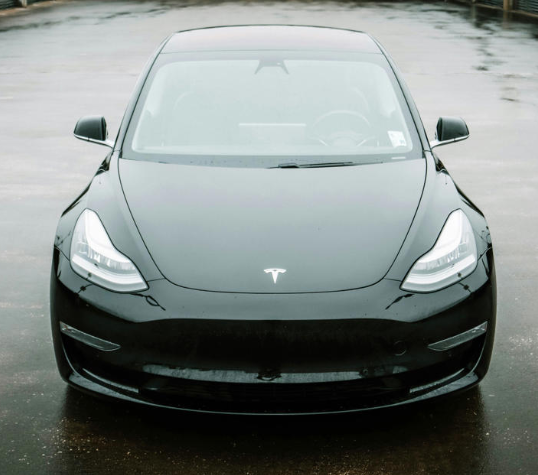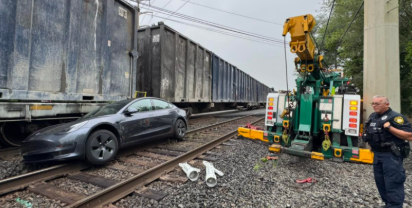In a shocking early morning incident in Pennsylvania, a Tesla vehicle operating in autonomous mode was struck by a train after it drove onto active railroad tracks. Thankfully, the driver escaped moments before the crash. However, the event has raised serious questions about the reliability and safety of Tesla’s Full Self-Driving (FSD) system.
This accident took place in Sinking Spring, Berks County, and has caught national attention. It highlights growing concerns around how far self-driving technology has come and how far it still has to go.
What Exactly Happened?
The accident occurred around 5:30 a.m. when a Tesla Model 3, reportedly running in Full Self-Driving mode, made a wrong turn and drove 40 to 50 feet onto the train tracks. Before the car could reverse or redirect, it came to a stop right in the path of an oncoming train.
The driver, recognizing the danger, quickly exited the vehicle. Moments later, a freight train clipped the Tesla, ripping off its side mirror and slightly damaging the body of the car. Luckily, no one was injured in the crash.
Emergency responders acted swiftly, halting rail traffic and calling in special equipment to lift the Tesla off the tracks. Authorities feared damage to the battery pack could lead to a fire or explosion, but fortunately, no such damage occurred.
Driver Blames Tesla’s “Self-Driving” System
The driver told local police and reporters that the Tesla was in Full Self-Driving (FSD) mode at the time of the accident. According to the driver, the car independently turned onto the tracks, seemingly mistaking the railway as a proper route.

While Tesla markets FSD as a highly capable driving system, it is officially classified as a Level 2 autonomous system, meaning it still needs constant human supervision. Tesla’s own documentation warns users to stay attentive and ready to take over at all times.
However, many experts believe Tesla’s branding of the feature as “Full Self-Driving” can confuse people into thinking the system is more advanced than it really is.
A History of Similar Incidents
This isn’t the first time Tesla’s autonomous features have been linked to incidents involving train tracks. In recent years, social media and news platforms have shown videos of Teslas mistakenly turning onto railways, especially in poorly marked or dimly lit areas.
In one widely circulated clip, a Tesla on autopilot drove onto a light rail track in California. The driver called the system “broken” and said it shouldn’t allow cars to make such mistakes.
These cases show a pattern of navigation errors, particularly at unusual intersections or less commonly mapped roads like railway crossings. Many users have pointed out that Tesla’s system often relies on pre-loaded map data rather than real-time decision-making.
Experts Call for Better Safety Standards
Following this latest crash, safety experts and government agencies are once again urging Tesla and other automakers to improve their driver-assist systems.
“The name ‘Full Self-Driving’ is misleading,” said a transportation safety analyst. “Drivers might assume the car can handle everything. But the reality is it can’t. And situations like train crossings need 100% attention.”
The U.S. National Highway Traffic Safety Administration (NHTSA) has already launched multiple investigations into Tesla crashes involving Autopilot and FSD. While the technology has helped prevent some accidents, it has also been involved in serious and sometimes fatal mistakes.
A Word from Tesla and Elon Musk
As of now, Tesla and CEO Elon Musk have not made any official statements regarding this specific incident. However, in the past, Musk has defended the FSD system, saying it improves over time and will one day be far safer than human drivers.
Musk has also promoted Tesla’s plans to create a fully driverless robo-taxi fleet. But incidents like this continue to raise doubts about how close that vision is to becoming reality.
The Bigger Picture Are We Ready for Autonomous Cars?
This train crash may seem like a one-off incident, but it reflects a broader concern: Is the world ready for self-driving vehicles? Technology is advancing quickly, but real-world driving is messy, unpredictable, and full of split-second decisions.The biggest worry is not the technology itself, but how drivers use it. Many assume their Tesla can drive itself without input, even though the company has repeatedly warned that drivers must stay alert.

Until there are stricter rules, better AI models, and clearer labeling of features like FSD, accidents like this may continue to happen. Public trust in self-driving cars depends on transparency, accountability, and improved safety features.
Looking Ahead
The Tesla train crash in Pennsylvania is a serious reminder that even the most advanced cars can make dangerous mistakes. The driver was lucky to escape unhurt, but things could have gone very differently.
Tesla’s Full Self-Driving mode may be a step toward the future, but today’s reality shows that it’s not quite ready for every situation especially those involving train tracks, unusual turns, or poor visibility.
As one observer put it:
“A car that can’t recognize train tracks isn’t ready to drive itself.”

